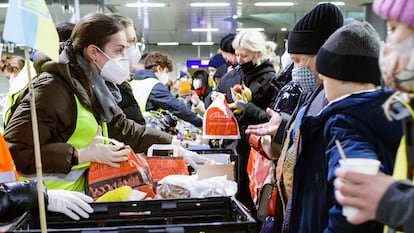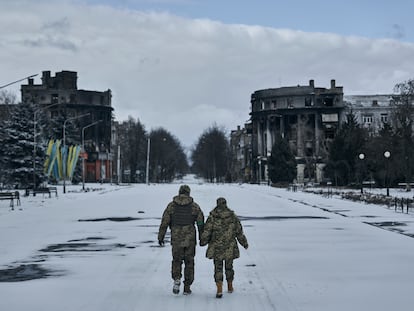German population reaches historic high after arrival of over a million Ukrainian refugees
The EU’s biggest economy has taken in more asylum seekers as a result of the Russian invasion of Ukraine than in total during the crisis of 2015 and 2016


In just under a year, Germany has taken in more people from Ukraine than arrived in the country in total during the refugee crisis of 2015 and 2016. Since Russia launched its full-scale invasion on February 24, 2022, around 1.1 million Ukrainians have sought refuge in Germany. Just over two thirds of these arrived during the first three months of the war, between March and May, 2022. This mass migration has changed the structure of the immigrant population in Germany with Ukrainians now accounting for the second-largest foreign community behind Turks, according to data released Thursday by the Federal Statistical Office (Destatis).
Tens of thousands of Ukrainians began to return to their homeland from May onwards, after Moscow’s attempt to take Kyiv was repelled. Destatis registered 139,000 returnees, bringing net immigration from Ukraine to Germany to 962,000 people. This represents a larger influx than the total number of refugees who arrived from Syria, Afghanistan and Iraq between 2014 and 2016, following the so-called Balkan route and who were able to enter Germany thanks to the open-door policy decreed by then-Chancellor Angela Merkel. Asylum seekers from these countries, who were mainly fleeing armed conflicts and poverty, totaled 834,000 people according to official data.
This new wave of migration has seen Germany’s population exceed 84 million for the first time in history with a growth of 1% in 2022 compared to the previous year. A population increase of this magnitude has only been recorded twice since German reunification: in 1992, when as a result of the opening of borders in Eastern Europe and the war in Yugoslavia, 700,000 people arrived, and during the refugee crisis of the mid-2010s.
The majority of Ukrainian arrivals in Germany are women and minors (63%). Men of military age, set at up to 60 years old by Kyiv, are not allowed to leave the country and must be registered with Armed Forces of Ukraine recruitment centers in case they are called up. Just over a third (35%) of asylum seekers in the EU’s largest economy are children and adolescents aged under 18. In total, these amount to around 300,000, whom Germany has had to integrate into schools.
Ukrainian refugees are automatically recognized as such by the country’s authorities as soon as they are registered, which has made it easier for them to receive benefits, German language courses and schooling for their children. The most populous states in the country, North Rhine-Westphalia and Bavaria, have taken in the largest numbers of Ukrainians.
“The study shows that the clear majority felt welcome in Germany”
Most Ukrainian refugees in Germany are housed in private apartments and have been made to feel welcome, according to a newly published study that provides representative data on their integration for the first time. The report is based on 11,700 interviews with Ukrainian arrivals conducted between February and June 2022. Of those people surveyed, almost three-quarters (74%) said they had moved into private accommodation immediately after arrival, meaning they did not have to pass through reception centers or be temporarily housed in government-supervised apartments.
The public-private study, which was carried out by the Federal Office for Migration and Refugees (BAMF) and the German Institute for Economic Research (DIW) among others, also notes that the uncertain course of the war prevents many refugees from planning a future in Germany: 37% said they wanted to stay permanently or for a few years, 34% said they wanted to return to Ukraine as soon as the war is over and 27% of respondents acknowledged that they were still undecided. Only 2% said they intended to leave Germany within a year or less.
“The study shows that the clear majority felt welcome in Germany,” said Nina Rother of the BAMF when the work was presented last December. The researchers found no significant differences in that response based on age or gender, which in their opinion is a reflection of “the great culture of welcoming and solidarity” in Germany. The experts also stressed the importance of integration measures implemented by Berlin. Refugees listed their most immediate needs during interviews: support to learn German, finding a job and finding an apartment. At the time of the survey, only 4% of arrivals said they had a good knowledge of German - a must for most jobs in the country - although half of respondents had already attended a language course.
Despite the fact that the readiness of the authorities to receive refugees was considerably improved in 2022 compared to 2014, many municipalities have started to lodge complaints with the federal government. These claim to be at the limit of their capacities and are demanding greater funding to meet health, education and housing needs. Minister of the Interior Nancy Faeser said Thursday that Chancellor Olaf Scholz will meet with the leaders of the federal states to discuss the issue. In the meantime, the federal government has not committed to allocating more state funds to the regions and municipalities.
Sign up for our weekly newsletter to get more English-language news coverage from EL PAÍS USA Edition
Tu suscripción se está usando en otro dispositivo
¿Quieres añadir otro usuario a tu suscripción?
Si continúas leyendo en este dispositivo, no se podrá leer en el otro.
FlechaTu suscripción se está usando en otro dispositivo y solo puedes acceder a EL PAÍS desde un dispositivo a la vez.
Si quieres compartir tu cuenta, cambia tu suscripción a la modalidad Premium, así podrás añadir otro usuario. Cada uno accederá con su propia cuenta de email, lo que os permitirá personalizar vuestra experiencia en EL PAÍS.
¿Tienes una suscripción de empresa? Accede aquí para contratar más cuentas.
En el caso de no saber quién está usando tu cuenta, te recomendamos cambiar tu contraseña aquí.
Si decides continuar compartiendo tu cuenta, este mensaje se mostrará en tu dispositivo y en el de la otra persona que está usando tu cuenta de forma indefinida, afectando a tu experiencia de lectura. Puedes consultar aquí los términos y condiciones de la suscripción digital.
More information
Archived In
Últimas noticias
Most viewed
- Sinaloa Cartel war is taking its toll on Los Chapitos
- Oona Chaplin: ‘I told James Cameron that I was living in a treehouse and starting a permaculture project with a friend’
- Reinhard Genzel, Nobel laureate in physics: ‘One-minute videos will never give you the truth’
- Why the price of coffee has skyrocketed: from Brazilian plantations to specialty coffee houses
- Silver prices are going crazy: This is what’s fueling the rally









































